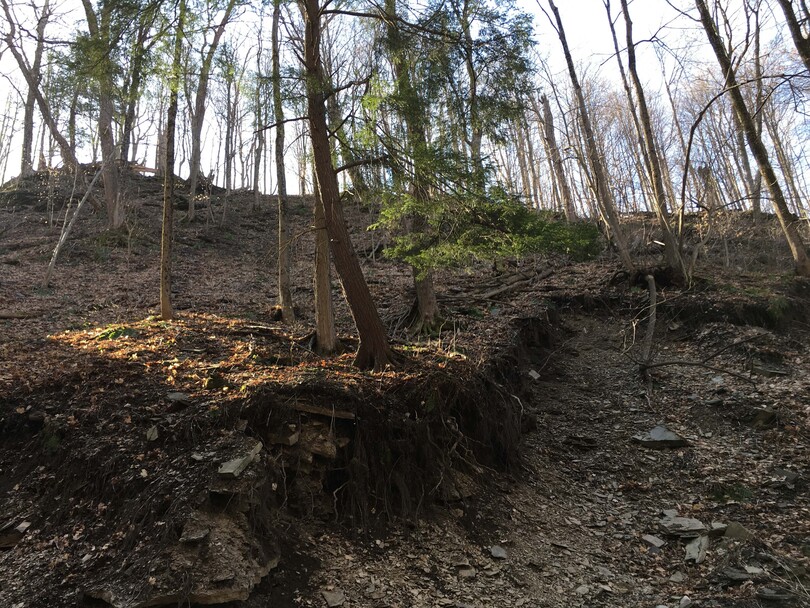New York State Hemlock Initiative aims to control Eastern Hemlock infestation

Photo Courtesy of Chris Travis
Eastern hemlocks are ideal for the Skaneateles Lake terrain because they grow well on steep slopes that border the lake.
Get the latest Syracuse news delivered right to your inbox.
Subscribe to our newsletter here.
UPDATED: April 11, 2022, at 1:50 p.m.
Carri Marschner and her colleagues at the New York State Hemlock Initiative have been studying predators of hemlock woolly adelgid since 2008. So, when members of the NYSHI collected needles containing Laricobius beetles, a naturally occurring method of keeping HWA at bay, in November and released them elsewhere in the state, Marschner felt proud about the accomplishment.
“We can go collect the beetles and re-release them somewhere else in New York,” said Marschner, an invasive species extension associate at the institute. “That feels like a milestone for us.”
Eastern hemlocks are evergreen trees native to the eastern U.S., and the trees’ future in central New York — and specifically around Skaneateles Lake — is in flux since HWA were spotted on the trees in central New York in the early 2000s.
Eastern hemlocks make up a significant portion of the trees surrounding the southern and western sides of Skaneateles Lake, where Syracuse gets the majority of its drinking water. Camille Marcotte, the water and ecology educator at the Cornell Cooperative Extension Onondaga County, said the trees are suitable for the slopes around the lake because they can grow tall on steep terrain. The trees are important for preventing soil erosion near the lake and filtering out harmful nutrients from making it into the water, she said.
“Those tributaries down there are so steep, and Hemlocks are like the only thing growing on them, so it’s holding back all that soil. And, if we lost them, to get trees established before we had problems with erosion would be impossible,” said Teresa Link, the Onondaga County Soil and Water Conservation District’s conservation district technician.

Hemlock woolly adelgids are recognizable by the white woolly adelgid that grows around where the insect latches onto a twig. PHOTO COURTESY OF TERSA LINK
The trees also slow snow melt by creating shade during the winter with their needles. The prolonged flow of cold water, as well as the shade created from the trees, keep the lake cooler into the warmer months, which creates a pleasant temperature for the fish to live in, Link said.
Since the NYSHI began researching predators to HWA, two insects — the Laricobius beetle and Leucopis silver flies — and two pesticides have been recognized to fight the tree’s sap sucking insect, Marschner said. In April 2021, SWCD received a $50,000 grant from the U.S. Department of Agriculture’s Forest Service Great Lakes Restoration Initiative, according to a press release from the organization. The grant funds the monitoring and control of HWA around Ostico and Skaneateles Lakes.
Link, the grant’s manager, said the money will help the SWCD monitor and control HWA in the Ostico and Skaneateles Lake watersheds. The five- to seven-year project will include treatment on 1,500 trees in the two watersheds, the press release said. These watersheds provide drinking quality water to nearly 500,000 people in Onondaga County, the release reads.
HWA is an insect that is native to Asia, and since making its way to the U.S., they have thrived on the starches of Eastern hemlock trees from the Great Smoky Mountains National Park to Skaneateles Lake.
The tiny black insects, which are recognizable by the white woolly mass around where they connect to twigs, prevent sap from reaching the entirety of the branch, Marschner said. While the insect has been in New York state since the 1980s, it has gradually moved north from New York City since then. The Eastern hemlocks die in about six to 20 years as new growth is inhibited.
“We think that what kills the trees is actually when you have a very high density of HWA, the tree can no longer get sap out to the end of its twigs to make new growth,” Marschner said. “The tree eventually starves.”
Link said when an Eastern hemlock is significantly affected by HWA the needles of the tree will fall off from simply tapping a branch.
Pesticides applied to the tree bark to kill HWA are effective, take a year to kick in and last four to seven years, Marschner said.
But, she is encouraged by the prospect of the Laricobius beetle to keep the HWA at bay now that it is naturally reproducing in central New York, especially since they have proven they can survive harsh winters in the region, she said.
“The reason that we’re so happy about that is that that means that that population is really thriving, which means that there are places in New York where the winter beetle can just reproduce naturally and succeed,” Marschner said.
While the Laricobius beetle preys on HWA during the winter, the NYSHI is also researching a summer predator — the Leucopis silver flies — to quell the sap suckers during the season of significant mating and reproducing. Marschner said the institute is determined to figure out in the next five years whether the silver flies will establish themselves in New York state as a viable predator to HWA.
“We’re not sure if we have establishment of the silver flies, (but) in the next five years we’re hoping to determine whether the silver fly will establish in New York,” Marschner said.
CORRECTION: A previous version of this post incorrectly identified what the SWCD is collecting and releasing. The previous version also incorrectly stated that there is only one chemical used to manage HWA. There are two. The Daily Orange regrets these errors.
CLARIFICATION: A previous version of this post stated Hemlock trees die in a few years in New York. They typically die in six to 20 years.





